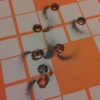I have seen bullets disintegrate due to centrifugal force like RC was talking about in #3. Same load one out of a 1:14 twist barrel is fine but it will come apart out of a 1:7, they were old Speer thin JHP bullets. That is not a heat issue though.
Hornady recently found that their plastic tips had been melting and changing the shape of the bullet resulting in loss of BC.
In this video,
https://www.youtube.com/watch?v=EnpwnYc0Sh8
Starting around 5:37 they show a simulation of some bullet fired and tip temperature.
At 2875 fps they show a temp of 792 degrees (I am going to assume F)
@ 2500 fps, 613 deg
@ 2262 fps, 519 deg
It might be worth noting that they don't offer a .224 bullet with the heat shield tip and it is not uncommon for them to operate well over 3000 fps. Also 792 F will melt the lead out of any bullet, if it gets to that temp but they obviously don't reach that internal temp to they would "splat" vs expand. A faster bullet will also get to the target faster than one moving slower, exposing itself to the heat for less time.
Other factors are also in play as well. Plastic is an insulator where lead is a conductor. So, a heated lead bullet would be more likely to conduct the heat from the tip to the rest of the lead vs holding it in the tip.
To illustrate this you can get lead, copper, steel and plastic rods, all the same diameter /length and hold each one (at the same point) above a flame and see what one you can hold the longest. If you have graphite it is neat to play with as well, one end can be glowing after enough time, and you can still hold the other end.
Also you can expose a lead bullet to a temperature of thousands of degrees, if the duration is short enough, you will see no damage. If you have some bullets and a torch you can see this for yourself; however, if you expose one to say 625 F long enough it will melt but no bullet would be in flight that long. That said, as above it was long enough to melt the non conductive tip that Hornady uses on other bullets (fired in some rifles at extended distances) to melt the plastic they use in them.
One other factor could be heat dissipation, for all intents and purposes a bullet flight is fairly instant, would take some testing how much heat the rest of a lead bullet could transfer from the tip down before melting.
Maybe some food for thought...
I would also be quite interested in being paid to find out the answers, an interesting subject indeed.



